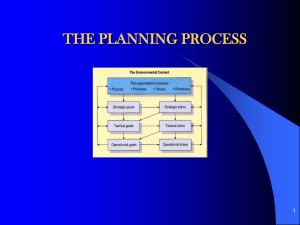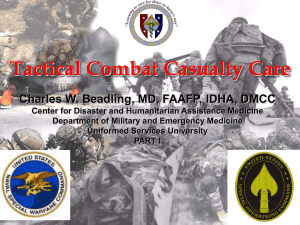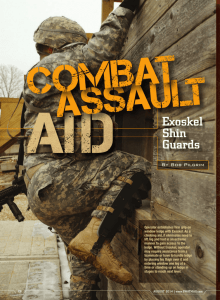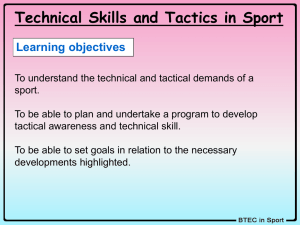Tactical Emergency Medical Support
advertisement
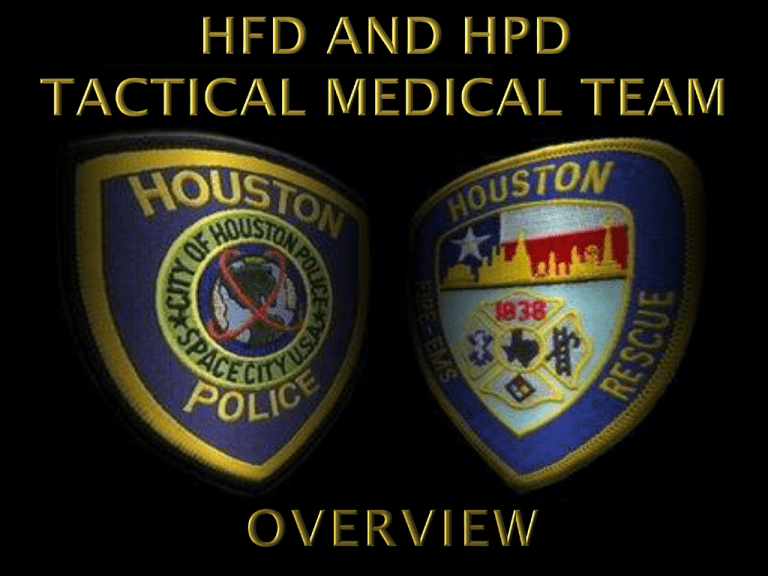
Special Operations Units in the military have utilized TEMS for years Recognize the value in immediate treatment EMS agencies generally do not provide the training necessary to operate in a tactical environment Concern over “Scene Safety” Requires consistent training with the local tactical unit to develop trust, proficiency, and understanding of their tactics Due to this recognized need, Tactical Emergency Medical Support was developed Specialized Medical Training Preventive Medicine Knowledge of SWAT and PD operations N.T.O.A. Position Statement “The National Tactical Officers Association believes that TEMS should be provided within the inner perimeter by tactically competent certified prehospital care providers under the medical control of physicians with tactical training.” US Army US Air Force Hostage rescue team has its own emergency medical contingency ICE unit (Customs) Pararescuemen (PJ’s) with their special tactics squadron FBI utilizes local or intra-department tactical medics to cover their tactical team Deploys physicians with their tactical medics Tactical Medics trained via Johns Hopkins ATF, US Marshals, DEA, US Park Police, Secret Service, Border Patrol State Police Over 600 Departments Wound Data and Munitions Effectiveness Team Study (Vietnam) 90% of combat deaths occurred in the battlefield 42% succumbed immediately 26% died within 5 minutes 16% survived between 5-30 minutes 8-10% died between 30 minutes-2 hours 42% within 30 minutes!!! Causes of Preventable Death Hemorrhage from extremity wounds (60%) Tension pneumothorax (33%) Airway obstruction (6%) 90% of all combat deaths occur before the casualty reaches a medical treatment facility Data from Vietnam 4% 9% 14% MSOF CNS Airway 85% Hemorrhage Hemorrhage: 31% Compressible 69% Non-Compressible From evaluation of 982 casualties, and casualties could have more than one cause of death. (Kelly J., J Trauma 64:S21, 2008) Per 1000 SWAT officer missions: 3.2 injured innocent bystanders 1.8 officer casualties 33 officer injuries 18.9 injured perpetrators Need for close medical support on call-outs Significant number of sports medicine related injuries during training, and call-outs. Sprains/Strains, Lacerations Primary Goals of a TEMS Unit: Enhance the probability of mission accomplishment Reduce mortality and morbidity among innocent civilians, officers, and suspects Reduce line of duty injury and disability costs Reduce lost work time for specially trained officers Maintain good team morale by exhibiting concern for the health and welfare of the SWAT team members Expectations of a Tactical Medical Provider: Provide immediate emergency care in the event of an injury to a civilian, team member, or suspect Coordinate on-scene care with available resources Monitor the medical effects of environmental conditions on individual team members as well as determine the potential impact of medical or health factors on a mission outcome Conduct in-service training of SWAT officers such as buddy first-aid through scenario development Physical Conditioning SWAT School Weapons Training Close quarters battle/combat Safety Understanding tactics Field Medicine Preventive Pre-hospital TCCC Critical Care/Trauma Care Hazardous Materials Toxicology, hazardous materials, infectious agents Advise command post regarding environment Familiarity with SCBA, Level A/B suits Methamphetamine Labs Special Equipment Maintain lightweight efficient equipment for rapid deployment Barricade/Warrant vs. Manhunt vs. Waterborne ops Sensory-deprived or overloaded patient evaluations Perform an evaluation under gunfire, in the dark, or austere environments On Duty Team 3 Physicians 9 Tactical Medics 1 Paramedic SWAT Officer Recruitment Physical, Background Check, Medical Review, Interview Continue to meet PT standard SWAT School 2 training days per month Must attend 75% UASI Grant 2010 Budget $252,174 Manpower for 2 first years Only covers training, not deployments Start up Equipment 2011 Budget $278,378 Team Maintenance Addresses turnover and equipment usage Addressed need to expand team Shortcomings in previous budget recognized Covers 2 years Unarmed, No TCLEOSE certification Inner/Outer Perimeter (Scenario Dependent) Expanded set of protocols Corneal Abrasion evaluation Antibiotics Expanded medications i.e.. Ketamine, Toradol, OTC meds Cricothyrotomy Workplace Johns Hopkins Mall School 11 injured police officers 7 injured civilians 2 fatally injured perpetrators 2,000 rounds of ammunition April 20, 1999 Two Seniors killed 12 students and 1 teacher Changed active shooter approach for PD April 16, 2007 Seung-Hui Cho killed 32 people November 26, 2008 10 coordinated shooting and bombing attacks Killed 164 people, wounding 308 Taj Hotel


